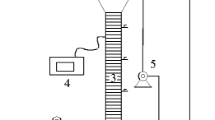Abstract
Batch experiments using acclimated sludge to sulfur utilizing autotrophic denitrification were performed to determine the applicability of spent sulfidic caustic in autotrophic denitrification as alternative sulfur and alkalinity sources. Fluorescence insitu hybridization (FISH) analysis showed that the microbial community of β-proteobacteria/ Eubacteria increased from 45% to 69% during enrichment period and nitrate removal reached up to 84% under this enriched sludge condition. In thiosulfate utilizing autotrophic denitrification, the initial condition at a sulfur/nitrate (S/N) ratio of 1.5 showed higher nitrate removal with 95.9%, and nitrate removal could be expressed by a first-order function of biomass concentration if all parameters such as pH, alkalinity and S/N ratio were in the optimum range. In spent sulfidic caustic utilizing autotrophic denitrification, the sulfate formation ratios to nitrate reduction were lower than those in thiosulfate utilizing autotrophic denitrification with a range of 2.65 to 2.78, and nitrate removal was over 95% at 1.0 and 1.5 S/N ratios. For S/N ratios of 1.0 and 1.5, initial alkalinities were sufficient to maintain optimum pH range of autotrophic denitrification. Furthermore, well enriched seeding sludge showed good activity of autotrophic denitrification at pH over 10. Therefore, spent sulfidic caustic could be effectively applied to autotrophic denitrification as an alternative sulfur source and an alkalinity source
Similar content being viewed by others
References
APHA,Standard Methods for the Examination of Water and Wastewater, 20th Edition, Washington DC (1998).
Batchelor, B. and Lawrence, A. W., “Autotrophic Denitrification Using Elemental Sulfur,”J. WPCF., August, 1986–2001 (1978).
Bisgoni, J. J. Jr. and Discoll, C. T. Jr., “Denitrification using Thiosulfate and Sulfide,”Journal of the Environmental Engineering Division, August, 593 (1977).
Claus, G. and Kutzner, H. J., “Phisiolosy and Kinetics of Autotrophic Denitrification by Thiobacillus denitrificans,”Appl. Microbiol. Biotechnol.,22, 283 (1985).
Flere, J. M. and Zhang, T. C., “Nitrate Removal with Sulfur-limestone Autotrophic Denitrification Processes,”Journal of Environmental Engineering, 125(8), 721 (1999).
Kim, E. W. and Bae, J. H., “Alkalinity Requirements and the Possibility of Simultaneous Heterotrophic Denitrification During Sulfur-utilizing Autotrophic Denitrification,”Wat. Sci. Tech., 42(3–4), 233 (2000).
Kim, I. S., Kim, S. Y., Kim, M. S., Park, W. S. and Jung, H. J., “Novel Nitrogen Control Process Dominated by Autotrophic Denitrifying Bacteria for the Treatment of Municipal and Industrial Wastewaters,”Journal of Korean Society on Water Quality,1, 67 (2004).
Koenig, A. and Liu, L. H., “Kinetic Model of Autotrophic Denitrification in Sulfur Packed Bed Reactor,”Wat. Res., 35(8), 1969 (2001).
Lee, J. W., Lee, H. W., Lee, S. Y., Kwon, S. Y., Choi, E. S. and Park, Y K., “Characteristics of Biological Nitrogen Removal Considering Autotrophic Denitrification and its Microbial Community,”J. of KSEE, 25(11), 1352(2003).
Liu, L. H. and Koenig, A., “Use of Limestone for pH Control in Autotrophic Denitrification: Batch Experiments,”Process Biochemistry,37, 885 (2002).
Matcalf and Eddy Inc.,Wastewater Engineering: Treatment, Disposal, Reuse, 3 rd revised ed., Revised by Tchobanoglous G., Burton F.L. New York, McGraw-Hill, 371 (1991).
Quan, Z. X., Jin, Y. S., Yin, C. R., Lee, J. J. and Lee, S. T.,Hydrolyzed Molasses as an External Carbon Source in Biological Nitrogen Removal, Bioresource Technology, adapted 17 December (2005).
Park, S. J., Kim, C. G., Yoon, T. I. and Kim, D. W., “Evaluation of Increased Denitrification in an Anoxic Activated Sludge using Zeolite,”Korean J. Chem. Eng.,20, 492 (2003).
Park, T. J., Lee, J. H. and Nam, H. U., “Removal ofNitrogen and Phosphorus using a New Biofilm Process-INRS (Innovative Nutrient Removal System),”Korean J. Chem. Eng.,16, 303 (1999).
Schramm, A., de Beer, D., Wagner, M. and Amann, R., “Identification and Activitiesin situ ofNitrosospira andNitrospira spp. As Dominant Populations in aNitrifying Fluidized Bed Reactor,”Applied and Environmental Microbiology, 64(9), 3480 (1998).
Schramm, A., de Beer, D., Gieseke, A. and Amann, R., “Microenvironments and Distribution ofNitrifying Bacteria in a Membrane-bound Biofilm,”Environmental Microbiology, 2(6), 680 (2000).
Sipma, J., Svitelskaya, A., Mark, B., Pol, L. W H., Lettinga, G., Buisman, G J. N. and Janssen, A. J. H., “Potentials of Biological Oxidation Processes for the Treatment of Spent Sulfidic Caustics Containing Thiols,”Wat. Res.,38, 4331 (2004).
Zhang, T. C. and Lampe, D. G., “Sulfur:limestone Autotrophic Denitrification Processes for Treatment of Nitrate-contaminated Water: Batch Experiments,”Wat. Res., 33(3), 599 (1999).
Author information
Authors and Affiliations
Corresponding author
Rights and permissions
About this article
Cite this article
Byun, IG., Ko, JH., Jung, YR. et al. The feasibility of using spent sulfidic caustic as alternative sulfur and alkalinity sources in autotrophic denitrification. Korean J. Chem. Eng. 22, 910–916 (2005). https://doi.org/10.1007/BF02705674
Received:
Accepted:
Issue Date:
DOI: https://doi.org/10.1007/BF02705674




